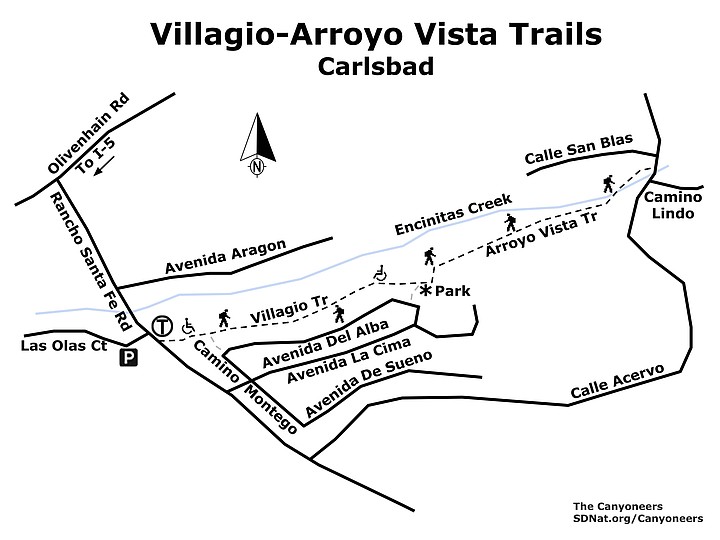 Facebook
Facebook
 X
X
 Instagram
Instagram
 TikTok
TikTok
 Youtube
Youtube

The Villagio and Arroyo Vista trail segments in southern Carlsbad are part of a series of wildlife corridors which allow animals to move from coastal Batiquitos Lagoon to inland areas and vice versa.
This suburban hike is named after the two housing developments that border it on the west and south as it follows Encinitas Creek from Rancho Santa Fe Road east to Calle Acervo. Park on the west side at the entrance to the Villagio subdivision, cross Rancho Santa Fe Road, and find the Villagio trailhead. The wide flat trail looks more like the entrance to an urban park here and can easily accommodate wheelchairs.
The trail meanders along the south side of the Encinitas Creek wetland area. Native plants such as coyote brush or chaparral broom (Baccharis pilularis ssp. consanguinea), western sycamore (Platanus racemosa), coast live oak (Quercus agrifolia var. agrifolia) and fuchsia-flower gooseberry (Ribes speciosum) intermingle with non-native garden escapees such as geranium and pampas grass. The trail is sandwiched between the Encinitas Creek wetland area on the north and the Vista Arroyo subdivision on the south.
Approximately 0.4 mile into the hike, a small neighborhood park provides another access point (from Avenida del Alba). From the small park, the trail becomes a single track (no wheelchair access) that descends down to the natural area. In early summer, the area may be thick with the large purple-flowered cardoon, the non-native artichoke thistle (Cynara cardunculus ssp. flavescens). Continuing east, a number of native plants may be spotted, including blue-eyed-grass (Sisyrinchium bellum), coastal sagebrush (Artemisia californica), lemonadeberry (Rhus integrifolia), long-stem golden-yarrow (Eriophyllum confertifolium), and sticky monkeyflower (Diplacus puniceus). Before reaching Calle Acervo, the trail crosses Encinitas Creek and passes by a profusion of yerba mansa (Anemopsis californica).
The cattails, sedges, and rushes along the tributary provide an excellent habitat for birds and other animals. If you are hiking in the midday heat, there can be less activity, but look to the sky to possibly spot a turkey vulture riding the thermal uplifts, listen for the mournful call of the mourning dove, and watch for the acrobatics of a pair of Anna’s hummingbirds on the return walk to the trailhead and your car.
These trail segments will eventually connect to a larger citywide system, and as part of the Multiple Species Conservation Program, they will provide an essential corridor for animal movement. Like many canyons and valleys in San Diego, the trail is bordered by subdivisions on all sides, highlighting the importance of safe corridors for animal movement. If you hike in the early morning or late afternoon hours, you are sure to find much more animal activity. Bring the entire family out for this short, easy-access hike!

VILLAGIO AND ARROYO VISTA TRAILS (Carlsbad)
Walk along a corridor critical for wildlife to move between habitats.


The Villagio and Arroyo Vista trail segments in southern Carlsbad are part of a series of wildlife corridors which allow animals to move from coastal Batiquitos Lagoon to inland areas and vice versa.
This suburban hike is named after the two housing developments that border it on the west and south as it follows Encinitas Creek from Rancho Santa Fe Road east to Calle Acervo. Park on the west side at the entrance to the Villagio subdivision, cross Rancho Santa Fe Road, and find the Villagio trailhead. The wide flat trail looks more like the entrance to an urban park here and can easily accommodate wheelchairs.
The trail meanders along the south side of the Encinitas Creek wetland area. Native plants such as coyote brush or chaparral broom (Baccharis pilularis ssp. consanguinea), western sycamore (Platanus racemosa), coast live oak (Quercus agrifolia var. agrifolia) and fuchsia-flower gooseberry (Ribes speciosum) intermingle with non-native garden escapees such as geranium and pampas grass. The trail is sandwiched between the Encinitas Creek wetland area on the north and the Vista Arroyo subdivision on the south.
Approximately 0.4 mile into the hike, a small neighborhood park provides another access point (from Avenida del Alba). From the small park, the trail becomes a single track (no wheelchair access) that descends down to the natural area. In early summer, the area may be thick with the large purple-flowered cardoon, the non-native artichoke thistle (Cynara cardunculus ssp. flavescens). Continuing east, a number of native plants may be spotted, including blue-eyed-grass (Sisyrinchium bellum), coastal sagebrush (Artemisia californica), lemonadeberry (Rhus integrifolia), long-stem golden-yarrow (Eriophyllum confertifolium), and sticky monkeyflower (Diplacus puniceus). Before reaching Calle Acervo, the trail crosses Encinitas Creek and passes by a profusion of yerba mansa (Anemopsis californica).
The cattails, sedges, and rushes along the tributary provide an excellent habitat for birds and other animals. If you are hiking in the midday heat, there can be less activity, but look to the sky to possibly spot a turkey vulture riding the thermal uplifts, listen for the mournful call of the mourning dove, and watch for the acrobatics of a pair of Anna’s hummingbirds on the return walk to the trailhead and your car.
These trail segments will eventually connect to a larger citywide system, and as part of the Multiple Species Conservation Program, they will provide an essential corridor for animal movement. Like many canyons and valleys in San Diego, the trail is bordered by subdivisions on all sides, highlighting the importance of safe corridors for animal movement. If you hike in the early morning or late afternoon hours, you are sure to find much more animal activity. Bring the entire family out for this short, easy-access hike!

VILLAGIO AND ARROYO VISTA TRAILS (Carlsbad)
Walk along a corridor critical for wildlife to move between habitats.